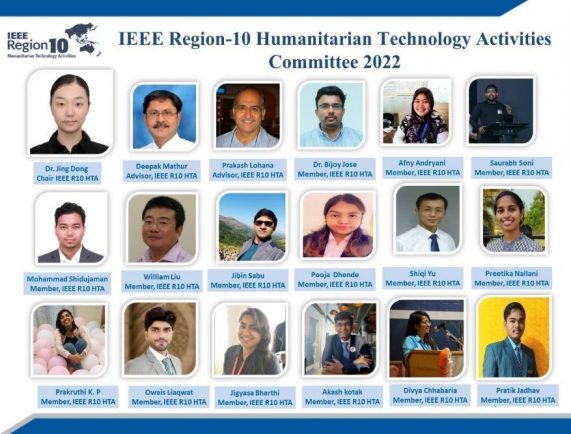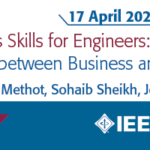Prepared by: Preethika Nallani, Newsletter Committee for IEEE R10 HTA, and Jing Dong, Chair for IEEE R10 HTA

IEEE Region-10 Humanitarian Technology Activities Committee -2022-23
IEEE Region10 and IEEE HAC have partnered to conduct a special Call for Proposals in Region 10 to support projects that utilize innovative technology to address the COVID-19 situation while keeping safety as the highest priority.
With this Call for Proposals, IEEE Region 10 and IEEE HAC aim to engage IEEE members in meaningful humanitarian technology and sustainable development activities, foster the development of IEEE relationships with communities and stakeholders at the grassroots level, and incubate a geographically diverse selection of innovative prototypes that could potentially be scaled up in the future – all with safety as the highest priority.
A total of 26 projects were selected under this project call, and given six-month duration to complete their projects. All projects are successfully completed, with the top 5 projects briefly discussed below. These 5 projects are selected due to their unique qualities and special objectives, and have been actively implemented in their areas/localities in collaboration with NGOs.
The blood test required for corona treatment requires one to collect the blood samples and send them to the laboratory for testing at the earliest. Further, corona patients need blood for their fast recovery, which again needs to be collected from pathology or blood bank, as per the requirement. This transportation from one place to another is time-consuming and prone to contamination. These are further complicated by traffic and/or road infrastructure. Transportation of biological specimens is currently done by various types of transport (plane, train, car, bicycle). Drones will revolutionize the transport system to handle such issues. This project proposed to develop a drone named ‘Maruti 2021’ to assist the medical emergency team in the event of COVID-19 or other pandemics. It will deliver a blood bag, collected blood samples and food packets like life-saving essentials for any COVID-19 patient avoiding contamination and ensuring fast delivery.
Video Link:
(https://drive.google.com/file/d/1Xr2PXaT17FDMdebWtB5uFWl6yXU-HQcf/view?usp=sharing)
The education field was really affected by the impact of COVID-19. Online education is comparatively less effective than offline classes since there is minimal physical interaction between students and teachers and students feel isolated. It is difficult especially for students in professional colleges to understand the concepts in online mode. In order to make a difference in this situation, we associated with Infosory Future Tech Labs Pvt Ltd and developed an app called TutAR app to bring SPARK. We implemented it to the LP students at Elampara LP School, Punnekadu LP school, Josephine LP School, and Vettampara Schools in Kerala. AR helps in visualizing the concepts which will definitely help students to learn better even in the online system. We would like to extend to more schools after successful completion. AR system is highly interactive in nature and operates simultaneously in real-time. The project gave unique digital experiences that blend the best of digital and physical world. The members of the team were provided with training sessions at different phases of AR which were informative and efficient; these helped them in the implementation process.
Video Link:
(https://drive.google.com/file/d/1CNecPuhK2xAp05ezFsRZstiPQPRADmj7/view?usp=sharing)
The Health Care Ecosystem in Uttar Pradesh that caters to primary and secondary levels of care has 3,621 Primary Health Centres (PHC) and 821 Community Health Centres (CHCs). PHCs/CHCs identified for COVID-19 management need to have a 24×7 assured oxygen supply (oxygen cylinders, oxygen concentrators, or other means). These CCCs should be mapped to one or more dedicated COVID Health Centers (DCHC)-PHC at least. To address the health care needs, an adequate number of oxygenators is needed as follows:
Video Link:
(https://drive.google.com/file/d/1OdakIEdExO1M9pE3AFDZT0C1F5k8H2I/view?usp=sharing)
This project develops a strap-on motor for wheelchairs used by disabled persons to minimize the risk of surface contact due to the hand propelling of the drive wheel. The project is to provide one prototype pack consisting of a pair of drive motor wheels and a hand controller. During the project time frame, we found it difficult to coordinate the effort of the team for the building phase due to the Delta variant surge in infection cases, in which several team members are also infected and a global surge of 2nd wave infection also causes delays in the delivery of the motors. The challenging aspect for future work is the severe devaluation of our currency that causes a significant rise in component procurement.
Video Link:
(https://drive.google.com/file/d/1-XHhry9j-XP2jK7nSaHqnIrE6nyaSFdT/view?usp=sharing)
Nowadays, we are suffering from the coronavirus pandemic. It is a virus that spreads through the physical interaction of people when they do not maintain social distance. Now the world is developing so fast that we cannot stop working and staying at home for a long time. The only way through which we can save ourselves is by considering SOPs and social distancing. So for this purpose, we conducted Virtual Awareness Seminars and introduced a project regarding the social distancing alert device, which has been installed at the administrative offices of the Faculty of Engineering, The Islamia University of Bahawalpur. This device alerts students/faculty to maintain the proper social distance from the clerical staff. In our university, students visit the clerk’s office during the whole day, which means there is a massive interaction between clerical staff and students/faculty. So to save our faculty, clerks, and students from this virus, we have installed this social-distancing device at the admin offices.
Video Link:
(https://drive.google.com/file/d/1E42j6dLmYC9vn0VddsP-y-qMtJol1-2u/view?usp=sharing)


